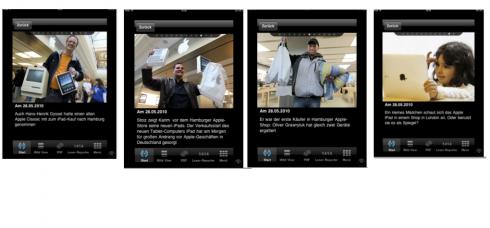Updated Saturday, May 29, at 08:34 EST
TAKEAWAY: The magnificent little iPad has made its Atlantic crossing and it seems people love it in Europe and beyond. AND: For the Japanese publishers, the one platform to launch their publications in a tablet.
My Tweet for today
No surprise: the lines are long to get that iPad across the world. Publishers take notice: they will read your title there, too

iPad Mania in Germany as seen thriough Bild Zeitung’s iPhone app
We already know that when the iPad goes on sale, lines of people outside the Apple stores follow. It has been the same today as the iPad goes out of the US, with buyers storming Japanese and Australian shops to be among the first outside the United States to snap up the tablet.
Friday was the first day the new technology was available outside the US, where Apple has sold one-million iPads in the first 28 days. The first countries outside of the US to get the iPad are Australia, Germany, France, Italy, Switzerland, Spain, the UK and Canada .
Meanwhile, in Japan
, publishers seem to be convinced the iPad is the perfect platform for their publications. This is, indeed, a big surprise, as I know that Japan’s publishers have been among the most cautious in terms of moving their titles online. With the iPad, however, the story is different. The major women’s magazine company Shufunotomo has said it will start an electronic bookstore for the iPad that will offer about 50 magazines and books. Yahoo Japan plans to offer 100 comics for the iPad free.
The Asahi Shimbun, Japan’s second-largest newspaper with a circulation of about eight million, said Thursday it would cooperate with Sony’s e-reader content platform, together with the cellphone carrier KDDI and the printing company Toppan Printing.
The virtual classroom

It is all about information architecture when you first start planning a tablet edition
I had a chance yesterday to do my first “online” Master Class. Sponsored by Print Magazine, the “webinar” attracted participants from all over the United States, Japan, South Africa, Bahrain and Europe. I must admit that I had some sketpticism as to how this would work. After all, I have done my share of teaching in university classrooms, not to mention speaking at conferences and conducting seminars worldwide. I thought I would miss the spontaneity, seeing that person in the back of the room raising his/her hand to ask a question.
So, I told seminar organizer, James Gaddy, of Print, who was moderating the session, to allow for participants to ask questions during the presentation, which they did.
Not surprisingly, the majority of the questions had to do with the last segment of my class, where I talked about the “tabletizing” of magazines and newspapers, and the opportunities there for designers to apply our craft to a new platform. As I mentioned the importance of information architecture in planning tablet editions, several class participants wanted me to offer them tips on how to read more about information architecture.
Here are two sources I recommend:
First, Information Architecture for the World Wide Web: Designing Large-Scale Web Sites , by Peter Morville and Louis Rosenfeld—-Here is a text that will introduce you to information arcthiecture as a discipline, but also give you tons of tips on how users behave when making decisions, how to tips for labeling and navigating thru masses of information, plus many case studies, including a favorite for me “architecting an online community”.
Second, I recommend visiting the Information Architecture Institute, a great source of materials on why information architecture matters.By the way, the Institute always capitalizes the I and A in information architecture for all references.
Preparing for the tablet
Several class participants asked me: how do I, a print designer, prepare to tackle the world of designing for the tablets?
I think that a lot of what we already do applies totally to designing for the tablet. We simply have to think in terms of the tablet’s possibilities, and this does not mean going crazy with multimedia and incorporating a video for every story. Not at all. Instead, the learning has to do with the subject of creating storyboards for content, utilizing photos better as storytelling tools, and, of course, emphasizing pacing and rhythm for how the content is presented.